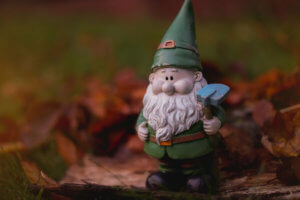Winters can be long and hard in Alberta so preparing your garden for the cold months ahead is important. The extra time and care will result in a healthy garden come springtime.
POTS – Pots and planters made from wood, cast iron, polyurethane, fibreglass, and non-porous plastic composites can be safely left outdoors over winter. Filling them with new soil every year gets expensive so this fall just remove the plants/flowers and their root balls. Then move your pots together into groups somewhere out of the way (and off the lawn). Put a small tarp over the pots to keep them dry and prevent cracking.
Smaller pots are often easier to empty, then flip them over and use bricks, pot feet, or pieces of wood to keep them off the ground.
Make sure your pots are strong enough for winter temperatures, terra cotta ones are best emptied, washed and bought inside as they are porous and may crack.
 LAWN – Going into fall, your lawn should be about 3” high. Mulch any leaves into it. The decaying leaves will act as a natural fertilizer, releasing nitrogen over time and acting as a weed suppressant in the spring. Just make sure the layer isn’t too thick and that you can still see the tips of the lawn through the leaves.
LAWN – Going into fall, your lawn should be about 3” high. Mulch any leaves into it. The decaying leaves will act as a natural fertilizer, releasing nitrogen over time and acting as a weed suppressant in the spring. Just make sure the layer isn’t too thick and that you can still see the tips of the lawn through the leaves.
Fall is the ideal season to overseed your lawn so it will come back thicker and healthier next year.
GARDEN – Top dress garden soil. Add mulch/compost to a depth of up to 5 cm (2 inches) — around the perennials, not over top of them. Mulch can be straw, shredded leaves/foliage or bark. If you have existing bark mulch, just top up if required. The mulch will act as insulation, bettering the chance of surviving the winter.
Tidy perennials cut them down to just above the ground and remove any dead flowers, leaves or seed pods.
Don’t prune or fertilize plants late in the fall; otherwise, you’ll stimulate new growth, which will only suffer damage during the heavy frosts.
Fall is the season for planting new bulbs. They’ll lie dormant over the winter and once the ground starts to warm up in the spring you’ll be rewarded with bursts of colour in your garden. It is now time to dig up any summer bulbs that won’t survive outside over the winter and bring them indoors.
Vegetable gardens should have a final tilling to eradicate as many weeds as possible before spring comes again. Top with manure or compost.
TREES – Prevent insect damage on deciduous trees via the use of dormant oil; don’t spray the oil during freezing temperatures.
Stake and tie up any young trees or shrubs that may break under the weight of wet snow or ice.
FINAL NOTES – Put up bird feeders in a safe and dedicated area of your garden. Many wintering birds become dependent on bird feeders during extremely cold or stormy weather.
While we don’t recommend using Google for your health issues it is a good source for your garden’s health. If you have roses, lilacs, a new tree or shrub that you are unsure about going into the winter a google search can reveal helpful and expert advice.
Here is the link to the Alberta Plant Hardiness Zone Map – http://bit.ly/2Ny21UY
Contact us if you need some assistance getting your garden and landscape ready for winter.







